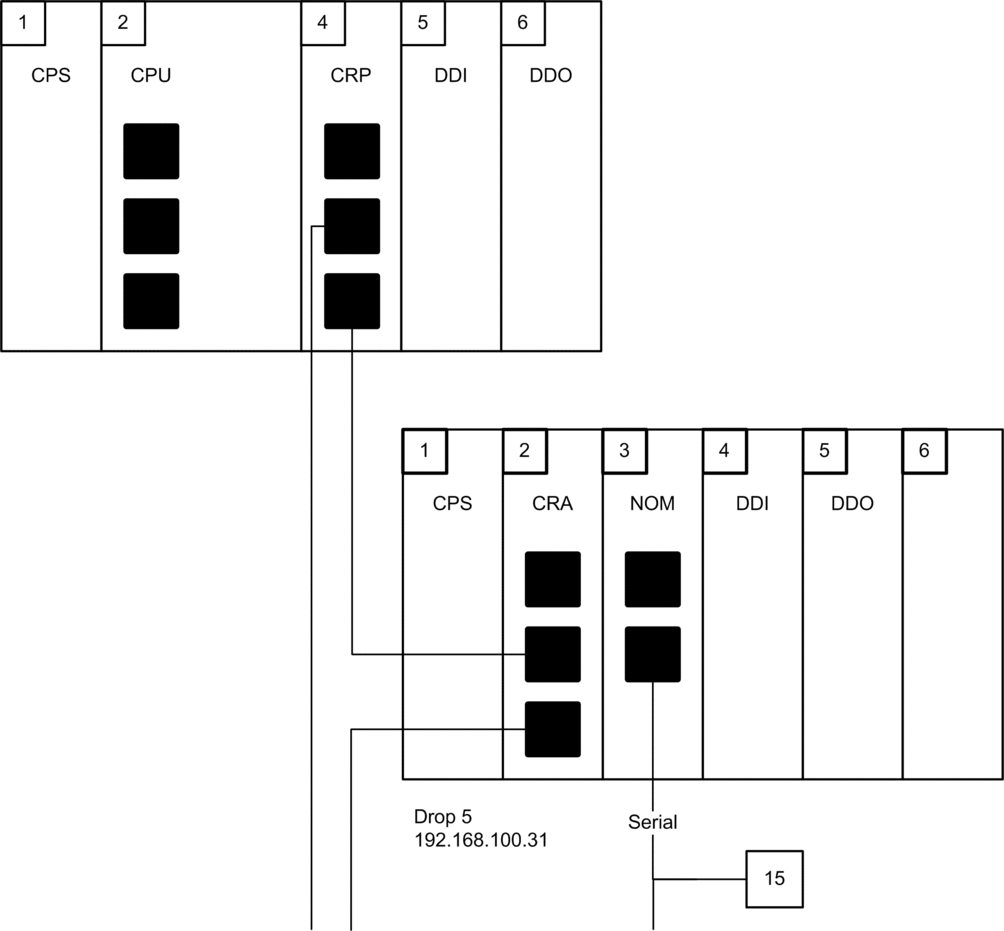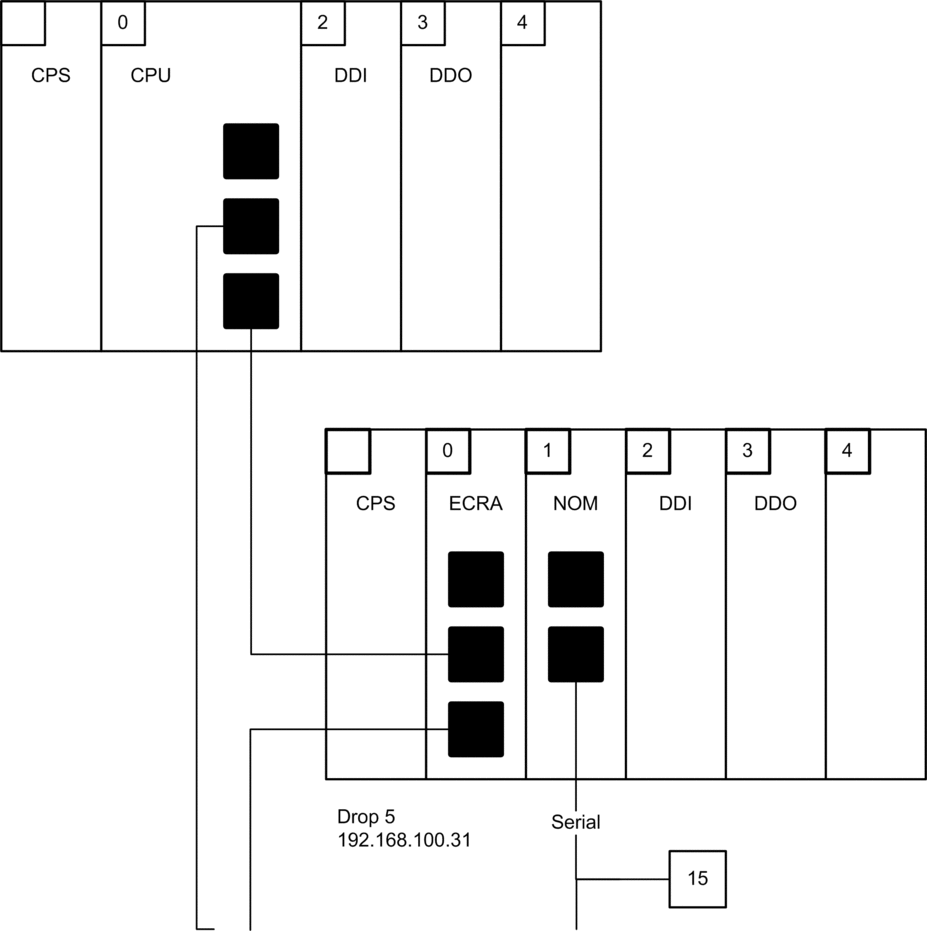Function Description
The ADDMX function is used to convert a character
string respecting the Control Expert device
address syntax into an array of integers in order to manage (e)X80 serial link modules in an Ethernet I/O drop.
The ADDMX function can be used directly by the following communication functions
with a local Modicon M340 CPU or a remote M340 module in a Quantum system:
READ_STS_QXWRITE_CMD_QXEXCH_QXREAD_REG_QXWRITE_REG_QXPRINT_CHAR_QX
The ADDMX function can be
used directly by the following communication functions in an M580 system:
READ_STS_MXWRITE_CMD_MXREAD_PARAM_MXRESTORE_PARAM_MXSAVE_PARAM_MXWRITE_PARAM_MXINPUT_CHARPRINT_CHARREAD_VARWRITE_VARINPUT_BYTEDATA_EXCHSEND_EMAIL
The additional parameters EN and ENO can be configured.
FBD Representation

LD Representation

IL Representation
ADDMX (
IN := InputADDMX
)
ST OutputADDMX
ST Representation
OutputADDMX := ADDMX (IN := InputADDMX);
Parameter Description
The following table describes the input parameter:
Parameter |
Type |
Comment |
|---|---|---|
|
Character string |
String complying with Control Expert device address syntax that contains the path from the CPU module to the EIO drop module and the path inside the EIO drop module to reach the targeted module. Each path is separated by \\ characters inside the string. |
To address a BMX CRA 312 •0 or BME CRA 312 •0 module directly
with its IP address, the IN parameter takes one of
the 2 following forms:
‘r0.s0.ch0.{ip.ip.ip.ip}’
‘r0.s0.ch0.{ip.ip.ip.ip}TCP.MBS’
To address a Modbus server or slave using Modbus protocol, the IN parameter takes one of the 2 following
forms:
‘r0.s0.ch0.{ip.ip.ip.ip}TCP.MBS\\r1.s1.ch1.d’
‘r0.s0.ch0.{ip.ip.ip.ip}TCP.MBS\\r1.s1.ch1.d.MBS’
Detailed description of Control Expert device address syntax string content:
Field |
Value |
|
|---|---|---|
r0.s0.ch0 |
Topological address of the Quantum CRP or Quantum NOE module or M580 Ethernet port that will send the TCP/Modbus request (rack, slot, and channel number). NOTE: In a Quantum rack: r0 = 1 and ch0 = 1.
NOTE: For a M580: to configure a communication through the CPU
Ethernet port, set channel number to 3 (0.0.3).
|
|
{ip.ip.ip.ip} |
BMX CRA 312 00 or BMX CRA 312 10 module with ip.ip.ip.ip address (protocol TCP port 502, default IP protocol, and port). |
|
TCP.MBS |
Optional, used to address a Modbus server |
|
\\ |
Separator |
|
r1.s1.ch1.d |
Modbus server module rack, slot, channel, and Modbus slave number Depending on the addressing mode, the parameters can be partly used as described: |
|
r1.s1 |
Module server addressing mode: module server topological address in a rack with a BMX CRA 312 10 module. NOTE: Modicon M340 first rack number = 0 (r0
= 0).
|
|
r1.s1.ch1 |
Channel server addressing mode: channel server address in the rack. NOTE: Modicon M340
first channel number = 0 (ch1 = 0).
|
|
r1.s1.ch1.d |
Modbus slave addressing mode: address Modbus slave n° d, using channel ch1 Modbus Master from a NOM module located in a rack with a BMX CRA 312 10 module. |
|
MBS |
Optional. To address a Modbus server if the NOM module is not a Modbus master. |
|
Examples of Quantum drop:

Device to Address |
ADDMX Syntax |
|---|---|
Module server of drop #5 CRA |
ADDMX('1.4.1{192.168.100.31}SYS |
Module server of BMX NOM in drop #5 |
ADDMX('1.4.1{192.168.100.31}\\0.3') |
Modbus device #15 on serial link of BMX NOM in drop #5 |
ADDMX('1.4.1{192.168.100.31}\\0.3.1.15') |
Examples of M580 drop:

Device to Address |
ADDMX Syntax |
|---|---|
Module server of drop #5 CRA |
ADDMX('0.0.3{192.168.100.31}SYS |
Module server of BMX NOM in drop #5 |
ADDMX('0.0.3{192.168.100.31}\\0.1') |
Modbus device #15 on serial link of BMX NOM in drop #5 |
ADDMX('0.0.3{192.168.100.31}\\0.1.1.15') |
The following table describes the output parameter:
Parameter |
Type |
Comment |
|---|---|---|
|
|
Array containing at least 2 This parameter can be used as an input parameter for several communication functions. |
The ADDMX block analyses the addressing string syntax (IN parameter) and puts the result into an array of array
which defines the destination address. The destination address can
be provided either by the OUT parameter of the ADDMX
function or directly by an array of array (n x 8 INT objects). However,
it is strongly recommended to use the ADDMX function to address a
communication EF.
Detailed description of ADDM_TYPE array:
Field |
Size |
Value |
|---|---|---|
Type |
1 byte |
reserved (2) |
ClientID |
1 byte |
0 if not specified |
Rack |
1 byte |
module rack number |
Slot |
1 byte |
module slot number |
Channel |
1 byte |
channel number inside the module |
ProtId |
1 byte |
This byte can have the following values:
|
AddrLen |
1 byte |
This byte can have the following values:
|
UnitId |
1 byte |
Optional: Device address or UNIT-ID |
AddrExt |
Array[7] |
Optional: Ethernet destination address extension |
| WARNING | |
|---|---|
| CAUTION | |
|---|---|


